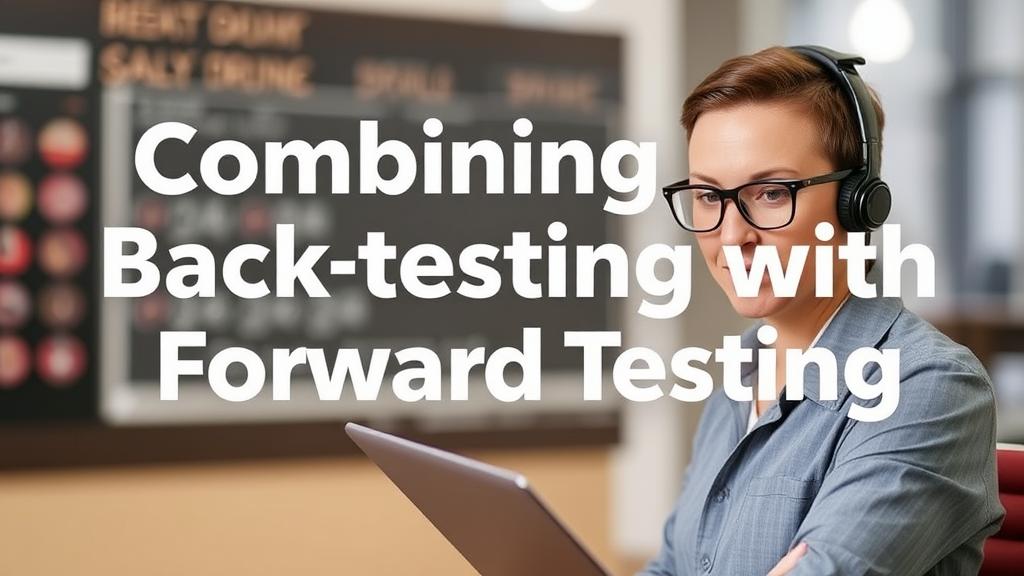Prompting Readers to Consider New Possibilities
What if your trading strategies could react in milliseconds? Algorithmic investing makes this possible—let’s explore the potential.
Combining Backtesting with Forward Testing: A Comprehensive Guide
In the world of trading and investment strategies, the quest for optimal performance is a never-ending journey. Traders often find themselves at a crossroads, trying to determine the efficacy of their strategies before deploying real capital. Two critical methodologies in this pursuit are backtesting and forward testing. Both play pivotal roles in the development of a robust trading strategy, but when combined, they can significantly enhance a trader’s confidence and success rate. In this article, we will explore the concepts of backtesting and forward testing, their methodologies, advantages, and how to effectively integrate both practices for superior trading outcomes.
Backtesting is a simulation method that involves applying a trading strategy to historical market data to evaluate its effectiveness. This process allows traders to gauge how their strategies would have performed in the past, providing a preliminary assessment before committing real funds.
The Backtesting Process
- **Data Collection**: Gather historical price data for the asset or market you wish to test.
- **Strategy Development**: Define the trading rules, entry and exit points, risk management parameters, and other relevant conditions.
- **Simulation**: Apply the strategy to the historical data, simulating trades as per the defined rules.
- **Performance Analysis**: Evaluate the results based on key metrics, such as:
- Total return
- Maximum drawdown
- Sharpe ratio
- Win rate
- **Optimization**: Adjust the parameters and refine the strategy based on the backtesting results to improve performance.
Advantages of Backtesting
- Time Efficiency**: Quickly assess a strategy’s viability over extensive historical data without risking capital.
- Data-Driven Insights**: Backtesting provides a wealth of data that can help identify patterns and anomalies in trading behavior.
- Risk Assessment**: Helps ascertain potential drawdowns and risks associated with the strategy before actual trading.
What is Forward Testing?
Forward testing, also known as paper trading or live testing, is the practice of applying a trading strategy in real-time market conditions without actual capital at stake. This phase is crucial for validating the effectiveness of a strategy in a live environment.
The Forward Testing Process
- **Select a Trading Platform**: Choose a brokerage or trading platform that supports paper trading.
- **Implement the Strategy**: Execute the trading strategy in real-time, but use a simulated account to avoid financial risk.
- **Monitor Performance**: Keep track of trades, noting any deviations from expected results.
- **Adjustments**: Make necessary tweaks to the strategy based on real-time observations and market behavior.
- **Evaluation**: After a predetermined period, assess the strategy’s performance using metrics similar to those in backtesting.
Advantages of Forward Testing
- Real Market Conditions**: Offers insights into how a strategy performs in current market dynamics, including liquidity and volatility.
- Psychological Factors**: Helps traders experience the emotional stresses of trading without financial risk.
- Live Feedback**: Provides immediate feedback on the effectiveness of the strategy, allowing for quick adjustments.
The Importance of Combining Backtesting and Forward Testing
While backtesting provides a solid foundation for strategy development, forward testing is essential for validation in real-world scenarios. Here’s why combining the two is crucial:
Bridging the Gap
- Historical vs. Real-Time Performance**: Backtesting can sometimes give misleading results due to overfitting or curve fitting, where a strategy appears profitable only because it was overly optimized on historical data. Forward testing helps highlight discrepancies between historical performance and real-time execution.
Comprehensive Evaluation
- Holistic Strategy Assessment**: Combining both methods allows for a deeper understanding of the strategy’s viability. Traders can analyze how well a strategy adapts to market changes over time.
Risk Management
- Informed Decision-Making**: By assessing performance through both backtesting and forward testing, traders can make more informed decisions about risk management strategies, including position sizing and stop-loss placements.
Best Practices for Implementing Backtesting and Forward Testing
To maximize the benefits of both methodologies, follow these best practices:
Backtesting Best Practices
- Use Quality Data**: Ensure that the historical data used for backtesting is accurate and clean. Inaccurate data can lead to misleading results.
- Avoid Overfitting**: Be cautious not to overly optimize the strategy to historical data, as this can lead to poor performance in future trading.
- Test Across Different Market Conditions**: Perform backtesting across various market cycles (bullish, bearish, and sideways) to assess robustness.
Forward Testing Best Practices
- Simulate Realistic Conditions**: When forward testing, ensure that the simulated trading environment mimics real market conditions as closely as possible.
- Maintain a Trading Journal**: Document every trade, including entry and exit points, reasoning, and emotions experienced during the trade. This record can provide valuable insights for future improvements.
- Set a Testing Duration**: Determine a specific period for forward testing, ideally covering various market conditions to gauge the strategy’s adaptability.
Conclusion
The integration of backtesting and forward testing is a powerful approach for traders looking to enhance their strategies. While backtesting offers a historical perspective, forward testing provides insights into how those strategies perform in real-time, dynamic markets. By employing both methodologies, traders can develop a well-rounded perspective on their strategies, leading to more informed trading decisions and improved risk management.
In an ever-evolving trading landscape, the combination of these techniques not only enhances the likelihood of success but also builds the trader’s confidence in their approach. As you embark on your trading journey, remember that the road to success is paved with careful analysis, continuous learning, and the judicious application of both backtesting and forward testing.



